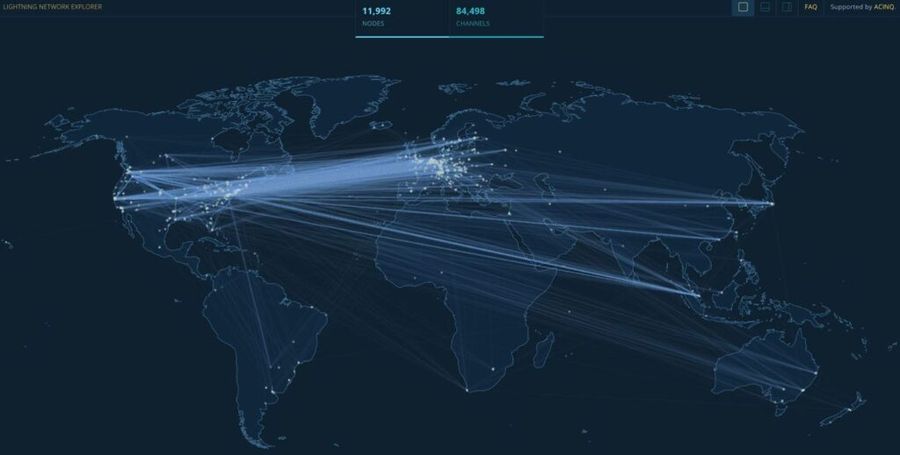Ah, the Lightning Network… The flashy sidekick to Bitcoin, swooping in to save the day when it comes to fast and affordable transactions. While Bitcoin may be a great store of value, let’s face it, it’s as slow as a snail when it comes to everyday transactions. That’s where the Lightning Network comes in.
You see, for Bitcoin to truly compete with payment giants like Visa, it needs to process transactions faster than a cheetah on caffeine and at a fraction of the cost. But here’s the catch: it can’t sacrifice decentralization or security in the process. It’s the age-old Bitcoin trilemma.
Why Use Lightning Network?
The Lightning Network is the answer to this conundrum. It’s a layer two solution that takes the burden of small transactions off the Bitcoin blockchain and instead uses micropayment channels. It’s like a secret underground tunnel system, allowing you to zip your payments through without clogging up the main highway. It was first proposed back in 2015 by Joseph Poon and Thaddeus Dryja, the crypto masterminds of their time.
Here is a useful guide on how it works.
Now, let’s talk about the key features of the Lightning Network. We’re talking about speed, my friends. While Bitcoin can currently handle a measly 2-7 transactions per second, the Lightning Network can process thousands or even hundreds of thousands of transactions instantly. It’s like going from a bicycle to a rocket ship. And the best part? It’s perfect for those microtransactions as small as four satoshis (sats). That’s right, we’re talking about buying a cup of coffee with Bitcoin here.
Prerequisites of Using Lightning Network
To use the Lightning Network, you need to understand a few key concepts. Those are (in a nutshell):
Nodes: First up, we have nodes. Think of them as the cool kids who connect to the Lightning Network to send and receive bitcoin from other nodes. They’re like the gatekeepers of this lightning-fast club.
Channels: Then we have channels. These are like private tunnels that users of the Lightning Network create to transact with each other off-chain. It’s like having your own secret hideout to play with your friends and settle your debts. Pretty neat, right?
Invoices: And what about invoices? Well, these are like fancy requests for payment on the Lightning Network. They come in the form of QR codes, containing all the necessary information to complete a payment. It’s like a secret code that unlocks the door to your treasure chest.

How to pay on the Lightning Network
Now, let’s get down to business. How do you actually use the Lightning Network? There are a few ways to go about it. The simplest option is to use a custodial Lightning wallet. Take Bottlepay, for example, but feel free to choose your own. Bottlepay’s user experience is as smooth as butter, especially for beginners.
Just follow a few simple steps on your preferred custodial wallet, and voila! You have yourself a Lightning wallet. You can add funds, make payments at lightning speed, receive funds, send funds, and even trade.
Transferring Bitcoin With Lightning Network
Making a payment through the Lightning Network is as simple as any other digital payment method and can be done by following these steps:
- Open the payer’s wallet on the Lightning page.
- Click on “Send.”
- Scan the merchant’s or an individual’s QR code button or enter the address manually.
- Confirm everything is correct and proceed with the checkout.
Similarly, to receive Bitcoin with Lightning, the following steps may help:
- Open your wallet on the Lightning page.
- Click on “Receive.”
- Scan your QR code button on the payer’s device or have the person enter the address manually.
- Confirm everything is correct and proceed with the checkout.

How to fund your Lightning Network wallet with BTC
In order to open a channel or process a payment, a user will need some BTC funds in the wallet. To send Bitcoin to a wallet, here are the steps to follow:
- You should set up your wallet to use the Bitcoin base chain (Bitcoin wallet) or the Lightning Network (Lightning wallet). Select the wallet network you want to use.
- Go to “Receive” and click on it.
- Check the transaction details are correct.
- Scan the QR code or copy and paste the receiving address onto the wallet you’re getting your funds from.
- You have the option to add an invoice for the payment. Click on the “Invoice” button to proceed.

Once you’ve received BTC and opened a channel, you can send and receive Bitcoin with no time or amount limits. The Lightning Network is still considered experimental and must be refined, and it is therefore recommended not to store a significant amount of BTC in a Lightning wallet.
Current trends and developments related to the Lightning Network
● Increasing number of nodes and channels, leading to improved liquidity and connectivity.
● The emergence of Lightning Network service providers and infrastructure companies.
● Development of Lightning-enabled wallets and applications for user convenience.
● Focus on interoperability and compatibility between different Lightning implementations.
● Advancements in privacy and security, such as onion routing and network resilience.
Potential for new applications and use cases in the future
● Microtransactions: Enables small, frequent transactions for content creators, online gaming, and pay-per-use services.
● Cross-border transactions: Provides an efficient and cost-effective solution for remittances and international trade.
● Decentralized applications (dApps) and smart contracts: Allows for the development of innovative applications leveraging the Lightning Network’s fast and scalable infrastructure.

These trends and potential applications highlight the growing significance of the Lightning Network in revolutionizing the way Bitcoin transactions are conducted, paving the way for a more efficient and inclusive financial ecosystem.
Thanks to the Lightning Network, you can now grab a cup of coffee, pay for it with a flicker of lightning, and be on your way with a smile on your face and a caffeine boost in your system.
But the Lightning Network doesn’t stop there. It’s not just about coffee and small transactions. It has the potential to transform the way we interact with money on a global scale. Imagine sending money across borders in an instant, with fees so low they make your piggy bank blush. Think of the possibilities for decentralized applications, smart contracts, and micropayments that can empower content creators and revolutionize online experiences.
Sure, there are still some challenges to overcome, like setting up lightning nodes and improving liquidity. But as the Lightning Network continues to grow and evolve, these hurdles will be tackled faster than you can say “HODL.”
So, embrace the lightning, my friends. Get your wallets ready, open those payment channels, and let the sparks fly. The future of Bitcoin transactions is here, and it’s electrifying!



